Tapas Roy1, Sudas Roy2, Sayantani Roy Choudhury3
1Operations Management, Indian Institute Planning & Management (IIPM), Kolkata, 700091, India
2Marketing Management, IIPM, Kolkata, 700091, India
3Economics, IIPM Kolkata, 700091, India
Correspondence to: Tapas Roy, Operations Management, Indian Institute Planning & Management (IIPM), Kolkata, 700091, India.
| Email: |  |
Copyright © 2012 Scientific & Academic Publishing. All Rights Reserved.
Abstract
In the growing body of literature on the issue of “Land Acquisition”, not much work has been done to directly map the responses of the land losers or evictees on the issue of “involuntary” parting with land. This paper has attempted to “profile” the characteristics of the “willing” land givers who, given the fulfilment of their “expected” compensation, would make available their lands for alternative uses like industry, schools or hospitals. Three researchers from IIPM Kolkata have conducted a primary survey of rural households located in five districts of the state of West Bengal in India to profile the “willing” land givers. The survey has revealed that the respondents with higher “education”, bigger “landholdings”, belonging to “general caste” and engaged primarily in “non-agricultural occupation” are more “willing” to part with their lands. The study has also revealed that the respondents living in “kaccha (mud) houses” are more “willing”. The “willing” land givers expect compensation based on multiples of “current market value”. The study shows that this multiple has a rising trend as the location of the respondents keeps approaching Kolkata, the State’s political capital.
Keywords:
Land Acquisition, Public Purpose, Fair Compensation, Eminent Domain, Willing Land Giver, Binary Logistics Regression Model, Combinatorial Analysis, Compensation Expectation
Cite this paper: Tapas Roy, Sudas Roy, Sayantani Roy Choudhury, Land Acquisition-Profiling the “Willing” Land Givers: An Indian Case Study, International Journal of Applied Sociology, Vol. 3 No. 3, 2013, pp. 59-69. doi: 10.5923/j.ijas.20130303.3.
1. Introduction
1.1. Genesis of the Study
Growing pressure of population, rapid urbanization, political quest for high GDP numbers and growing impatience to enjoy a higher material standard of living, have brought the question of land utilization to the political center stage in many countries. Any plan to build large scale manufacturing enterprises, and major physical infrastructure projects require large uninterrupted plots of land. This often involves acquisition of land, raising complex issues of “displacement” and “rehabilitation”, thus creating conflicts and adding to the real “cost” of land acquisition. India has not been immune to this process.Studies on the broad topic of “land acquisition” have so far confined themselves mainly to policy level analysis, analysis of various judgments delivered by the judiciary or to formulate compensation models for what would be considered as “fair” compensation or to seek answers to what constitutes public purpose or “eminent domain”. No attempt has so far been made to gain insight into these issues from the perspective of the landowner by seeking his responses
1.2. Structure of the Paper
This paper is sequenced as historical background and literature review, followed by study rationale and objectives and then the main body of the paper featuring methodology and discussion. The paper ends with a conclusion.
1.3. Historical Background and Literature Review
Historical records and the extant literature have broadly studied and documented the issues related to land and land acquisition mainly from the following perspectives: a) legal issues related to ownership rights; b) right of compulsory acquisition by the authority or the principle of “eminent domain and the associated issue of compensation and c) political decision making process.
1.3.1. Legal Issues Related to Land Ownership
From time immemorial, land has always been a source and symbol of economic and political power. With the evolution of society, a need was felt to define its ownership rules. Irrespective of the form of governance, societies, in general, accepted the individual's right to own/lease, use, dispose of and bequeath lawfully acquired possessions including land. Over time, the concept of dominium (exclusive right) and imperium (overall right of the state) on property came in, reference to which could be found in Roman law (Jacob 2008b: P59)[1] and also in the Napoleonic Code of 1804 (ibid59). These governing principles had given the state the power of overriding authority to decide on the possession of the land while granting the individual her right to property under this overriding condition.
1.3.2. Eminent Domain
The modern concept of right of the state to “eminent domain” owes its origin to the legal treatise of Hugo Grotius who upheld the authority of the State to infringe upon the property of subjects on all occasions, where ever the public good was involved (Paul,1987 P74-75)[2]. This authority was subject to the following two conditions:Expropriation was for public purpose and fair compensation was paid without delay for such loss.States have, in most cases, left the interpretation of the fulfilment of the above two conditions to the judiciary. In spite of varying socio-political and judicial systems, judiciaries across the world have attempted to interpret the conditions. The judgments being case specific, obvious differences cropped up in the interpretations. There have been instances where economic and legal experts have even questioned the veracity of the state’s right to intervene.a)Public purpose:“Public Purpose” has always been found important as a reason for state intervention in order to implement development (“schemes”) projects of the infrastructure variety commonly referred to as “public goods” for “public use”. These interventions are essential to ensure ease of land assembly for implementing large scale projects to hasten quick economic growth of a country/community. However, over the years, the role of government in providing “public goods” has undergone change. Private participation has become a common practice in providing services which were earlier typically in the exclusive domain of the government. This has made the government intervention necessary for the projects to be implemented by the private enterprises as well. This has expanded the original scope of “public use” in the eminent domain to include expropriation of land for private enterprises for economic rejuvenation.Mangioni(2009, p2)[3] has quoted Rosenberg to highlight the density dilemma of the earth’s population, where ninety percent live on approximately ten percent of the land. This has increased the need for land near congested urban areas to make provision for and renewal of public infrastructure and setting up of new industry. Governments have been using this imperative to justify the use of the “public purpose” clause..Miceli et all justified the use of public purpose to overcome problems of monopoly power of the individual owners whose lands were required for executing large projects (Miceli, Segerson 1999, P330)[4].Shavell (2007)[5] showed that eminent domain could be justified even when owners did not behave strategically to exploit their monopoly power. He held that the principle of eminent domain became effective if the number of land owners in a proposed “scheme” or “project area” was large and different owners fixed different reservation prices reducing the probability of a successful purchase drastically. Kalbro (2007)[6] has proposed a three- point test to determine the public interest: the benefits from the expropriation must exceed its cost, the value of the new land use must be higher than the existing use to the society and the buyer needs a particular area of land for which the seller is in a monopolistic situation.Merill (1986)[7] in his “Basic Model” has argued that in a “thin market”(where a seller can extract economic rents from a buyer because of the location of his property which is uniquely suited for the buyer`s need), “potential for engendering rent seeking may make it economically efficient to confer the power of eminent domain on a buyer”. But in a “thick market” (highly competitive market) setting, eminent domain is more expensive than market exchange. He has termed the use of eminent domain as the “ends approach” since it concerns the purpose to which the land is put. According to him judiciary has also generally adopted the “ends approach” by usually enquiring if the land would be used to provide for public benefit.Epstein (1985, P166)[8] held that the necessity and division of surplus must be present to satisfy the demands of the “public use” term. The basic theory of the public use demanded that in forced exchanges the surplus must be evenly divided. He also argued that the degree of public interest should dictate the level or amount of compensation payable. In cases where there was a low degree of public interest, Epstein argued that the compensation should be higher.Bird (2010)[9] took a stand in favour of “necessity” doctrine to limit the use of eminent power by judiciary. Here necessity implied imperatives or indispensability of the parcel of the land for the purpose of the project.Bird also quoted Lynch v. Household Finance Corp. (405 U.S. 538)[10], to show that there was no distinction between personal liberties and proprietary rights. It was recognized for long that rights to property were basic civil rights and should be protected with the same standard of review that was granted to other fundamental personal rights.It may be of interest to note the differences in the interpretation of the scope of “Public purpose” by the judiciary of a developed country like USA and a developing country like India, where differences can be seen in the judgments delivered by the courts of both the countries over time.Supreme Court of USA in the famous Berman vs. Parker case (348 U.S. 26)[11] concluded that “subject to specific constitutional limitations, when the legislature has spoken, the public interest has been declared in terms well-nigh conclusive”. A completely opposite view was expressed in the case Wayne v. Hathcock (684 N.W.2d 765)[12]where the Michigan Supreme Court, in the year 2004, rejected the argument that a private taking could satisfy the public use requirement merely by demonstrating a general economic benefit of the project to the community. “This was contrary to the fundamental protection of property rights afforded by the Constitution”. One year later in the sensational US Supreme Court judgment in the Kelo vs. City of New London[13], in a split judgment, the honourable court held that a city might claim private property under the Fifth Amendment, so long as it did so as part of a clear economic development plan intended to benefit the community as a whole (545 U.S. 469 [2005]). Judiciary in India has also been offering different interpretations while defining public purpose in different times. In 1996, it opined that the “Publication of declaration (by the government) under Section 6 (of the Land Acquisition Act of 1894) was conclusive evidence of public purpose”(10 SCC 150, 1996). However, in 2011, the honourable court held that “the application of the concept of ‘Public Purpose’ must be consistent with the constitutional ethos and especially with the Fundamental Rights and Directive Principles of the Indian Constitution” (DevSharan and Others vs State of UP,20111)[14] (Jayanta Bandopadhyay & Tapas Roy 2012,P. 23)[15].b) Fair Compensation:Epstein (1985, P164)[16] opined that appropriation of land for a public purpose and the quantum of compensation to be paid were two inseparable questions. He stated that the state’s exercise of its eminent domain power forced the private party to accept damages by way of “just” compensation and thereby allowing the state to capture without negotiation the entire transactional surplus, but only for the benefit of the public at large.However, US judiciary, defined “fair compensation” as the “fair market value” of the property, which was the highest price agreed to between a seller and a buyer without either party being unduly influenced for any reason and the one dealing with the other with full knowledge (Town of Islip v. Joseph Mascioli, 49 N.Y.2d 354 [1980])[17]. But, as John Bratland, (2006)[18] has pointed out, the act of taking property through compulsory acquisition is inherently confrontational and aggressive. By its spirit, there is no voluntary sale. In absence of the assent, no compensation can be considered just in the context of a takeover. Epstein (1985, Ch.18)[19] raised a new perspective when he commented that the money raised to finance compensation was a ‘taking’ from taxpayers for which they received ‘in kind’ compensation in the form of benefits from the public project. This necessitated the need to balance the compensation to land owners with the loss incurred by payment of higher taxes.Miceliet all (1999- p331) pointed out that the owners did not generally view land and wealth as perfect substitutes, whereas market value compensated their loss as if these were. He commented “Fair market value is not only unfair to land owners, it also potentially leads to an excessive transfer of private property to public use.”Calabresi and Melamed (1972)[20] distinguished between two categories of entitlement protection: “Property rules” and “Liability rules”. ‘Property Rules” refer to voluntary exchange in the market place. But eminent domain provides only “liability rule” protection for property owners, where the government might take private property by eminent domain as long as it paid the judicially determined “fair market value” award. Epstein argued that fair market value contained a systematic bias that underestimated the use value, which was typically in excess of its exchange value. Existing owner would not sell at market price because selling would deprive him of the surplus he could obtain from the current use (Epstein 1985, P182)[21].He argued that the central difficulty of the market value formula for explicit compensation was that it denied any compensation for the additional subjective value which increased the real value to the owner.Chang has also proposed the use of “economic value” rather than fair market value (Chang, 2012)[22]. His proposed economic value includes a schedule of bonuses along with fair market value. According to him, this takes care of the subjective value of the land giver (Ibid48). The central difficulty of the market value formula for explicit compensation, therefore, is that it denies any compensation for real but subjective values.Judge Posner, in a judgment (Coniston Corp. vs. Village of Hoffman Estates, 1988)[23] said “many owners value their property at more than its market value (i.e., it is not “for sale”). Such owners are hurt when the government takes their property and gives them just its market value in return. The taking in effect confiscates the additional (call it “personal”) value that they obtain from the property.” Judicial review has attempted to reduce the potential difference between the two, but an adversarial hearing cannot be an acceptable method for determining the subjective value to bridge the gap. Judiciary, in general, has also acknowledged this limitation. Reflecting this concern, in some recent legislative initiatives undertaken by certain states of USA, “just” compensation has been legislated as multiples of fair market value while limiting the use of eminent domain for private purpose (Article X, Section 2 of the Michigan Constitution: 2006)[24]. In Indiana, a condemner that acquires a parcel of real property through the exercise of eminent domain has to pay 125% for agricultural land and for residential property 150% of the fair market value of the parcel to the owner (Indiana Code - Section 32-24-4.5-8: Compensation for owners of acquired property).In England it is the “open market value”(under rule ii of the Compulsory Acquisition Act), which is considered as “fair market value”. It assumes a willing seller and ignores the increase in value created by the proposed developmental work (“no scheme world”) (Plimmer, 2008)[25]. In Australia the compensation is valued on Pointe Gourde Principle, which ‘cannot include any increase in value that is entirely due to the scheme underlying the acquisition’ (Mangioni, p.10). In India, Supreme Court has accepted the difficulty in estimating “Fair market value” and has relied on the “guesstimate” as a process, based on all the available inputs. Apart from the basic rule of taking the cue from a transaction of similar land between a willing seller and a willing buyer, it has recommended that highest bona fide sale value rather than average sale value of the similar land transactions be considered while deciding the compensation amount ( AnjaniMoluDessai Vs. State of Goa)[26]. The Court has also recommended considering the future (near term period) use of the land rather than only the current use of the land. This is over and above the solatium of 30% on the “Fair market value” which is provided in the Land Acquisition Act (Sec 23(2)).In the draft bill titled “Right to Fair Compensation, Resettlement, Rehabilitation and Transparency in Land acquisition Bill, 2012” , which is now awaiting final approval of the Indian Parliament, four times the market value in the rural area and twice the market value in urban area have been proposed as compensation payable in case of acquisition.The inherent limitation in arriving at any objective value for the “just compensation” is evident from the preceding discussions, since across the world the experts and judiciary differ on what should be considered “just”. This can be summed up through Justice Cheshin’s judgment in the Supreme Court of Israel, when in lyrical prose, he observed “Section 200 is anomalous and special. The criteria that the legislature has set for us to decide upon in compensation claims are “reasonableness” and “fairness” . . . . These, needless to say, are deeper than the ocean, higher than the skies, and one can discover everything within them.” (Alterman2007)[27]. c) Political decision making process:An interesting perspective on the issue of land acquisition was offered by Levinson (2000)[28]. He said “The role of government in the use of eminent domain is often guided by the political costs rather than financial ones”. Levinson observed that the evictees, because of their small numbers and geographical proximity, found it relatively easy to organize politically. The beneficiaries, on the other hand, often remained politically inert majority. But “Government actors respond to political incentives, not financial ones--to votes, not dollars”.Lunney, Jr (2000)[29] commented that political factors almost invariably influenced the selection of the project sites, instead of project benefit and the costs. He argued that when an interest group was better organized and more concentrated, it would tend to have disproportionate political strength, which influenced decisions that could distort the objective planning process. Variety of discourses and judicial opinions across the world have not yet come to any consistent, universally acceptable interpretation of two apparently innocuous terms: “public purpose” and “fair compensation”. Too many “local” factors and “contingent” conditions make this a nearly unattainable task.
2. The Study Rationale
From the earlier section, it becomes evident that so far no study has been attempted to directly map the responses of the land losers or potential evictees on the issue of “involuntary” parting with land. An issue like land acquisition is adversarial by its very nature. Hence, it is not unusual that the literature cited so far, are replete with judicial decisions as the problem is viewed in the domain of “natural justice”. However, the present authors believe that when such “natural justice” related discourses take place, the quality of the debate can be greatly enhanced and better decisions taken, if the opinions and responses of those who can be potentially affected by such takeovers are taken into account. Given this belief as the cornerstone of this study, a set of study objectives have been set up for focused and detailed investigations.
2.1. Study Objectives
The broad research objective of this study is based on the logical assumption that rural India (in this case, rural West Bengal) is both a cauldron and a kaleidoscope. We need to identify and incorporate multiple socio-economic characteristics to create different “profiles” of the land owning rural class to examine their varied perceptions and responses to the issue of land and land acquisition related questions.This study recognizes the reality that the rural population today is more heterogeneous in their relationship with land than their counterparts in the past. Non-farming sources have started contributing a large portion of earnings of the rural population affecting their dependence on land and their response to land acquisition issues. Spread of modern education among the rural population has also changed the aspirations, especially of the younger groups in rural India. On the other hand, in today's India, “religion” and “caste” continue to play important roles in shaping people’s opinion. Growing cost of inputs, declining fertility of land and inability to receive a “fair and remunerative price” for the output have made traditional agriculture a less profitable occupation.Against this back drop, the present team of three researchers, planned to conduct a descriptive cross sectional research study based on sample based primary survey to seek answer to the basic question: whether it would be possible to identify the “willingness” or “unwillingness” to part with the land by linking this dependent variable to a set of “profile” related socio-economic characteristics. If this attempt is successful, then different rural land owning households could be grouped under the two distinct heads of “willing” and “unwilling” with their distinctive socio-economic profile characteristics. Further, the study should be able to reveal that among the “willing” land givers, what range of “contingent” compensation amounts would be viewed as desired “pay-offs” by the respondents.Findings from such a study would have important policy level implications besides providing a “deeper”understanding of an issue like “perceived attachment” to the land for a land owner.
2.2. Study Design
Choice of Study Locations: The state of West Bengal was selected as the broad area of study. Land acquisition related issues have occupied political center stage in this state since 2007, leading to strong political division and turmoil ending up in violence in Nandigram (Nandigram Violence, Wikipedia)[30] and shifting of Tata Nano plant from Singur (West Bengal) to Sanand (Gujarat) (Financial Express, 4th October, 2008)[31]. Number of lives was lost and in the next state election, the political power shift happened. The ruling party’s policy on land acquisition was considered to be one of the major contributory reasons for this change. So it was in a way rather natural and logical that the research team would select West Bengal as the broad region for the study.Two maps reproduced here, help the reader to get a geographical feel of the state and its districts. Apart from the political and emotive dimensions of the problem. West Bengal also offers a fairly unique problem of preponderance of small rural farm holdings due to high population density and fragmentation of holdings through succession and inheritance. Average size of operational holding for kharif season in India is 1.1 ha as against that in West Bengal of 0.4 ha.(NSS Report 494, P.3)[32]. This accentuates the problem of land consolidation in West Bengal for acquisition of land for industrialization. 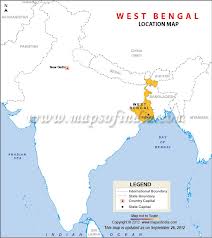 | Figure 1. West Bengal |
In selecting the target villages to choose sample respondent households, it was decided to avoid areas too close to the political capital, Kolkata or places which had remained politically charged due to recent events. Accordingly, districts like Hoogly, East and West Midnapore, North and South 24 Parganas were not considered. The objective was to select respondents from such locations which would offer better chance of getting more politically unbiased and spontaneous responses. Finally, five central districts of West Bengal, namely Burdwan, Birbhum, Murshidabad, Maldah and North Dinajpur were selected for the survey. 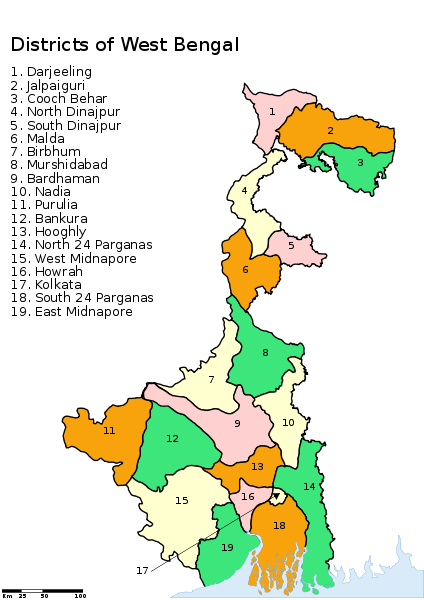 | Figure 2. Districts of West Bengal |
Table 1. The sample size and sample selection
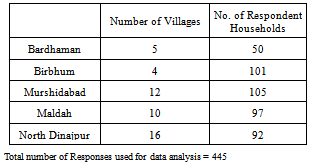 |
| |
|
The survey was conducted between July 2011 and June 2012.Typically, the investigators contacted the head of a household for eliciting responses. However, on many occasions, the relatively more educated/articulate male member (often the elder son) acted as the respondent and was considered as “surrogate” head of household for obtaining information. The choice of the village and the household within the village depended on factors like accessibility, maintaining some balanced representation amongst different religious, ethnic or caste groups as well as different land holding sizes. So to sum up, the sampling principle was “purposive” sampling such that different profiling parameters remained present in some minimum proportion to facilitate statistically valid analysis and interpretationIt may be noted that in administering the questionnaire, the respondent's willingness/unwillingness to part with the land was collected as a spontaneous response. Questions related to compensation were asked only to those who spontaneously showed willingness to part with their land (or a portion thereof).The study methodology did not take into account possibility of “converting” an unwilling land owner through a suitably calibrated scale of compensation
3. Methodology
3.1. Data Modeling
In this paper, a “binary logistic” multiple linear regression has been postulated. The dependent variable selected has been “willingness to part with” (Yes or 1) or “unwillingness to part with” (No or 0) while the independent variables have been the pre-selected socio-economic profile characteristics.
3.2. Data Description
When the total of 445 responses (see earlier section under Sample Size) was analysed, these yielded the following break ups in terms of different socio-economic variables: Table 2. Data description
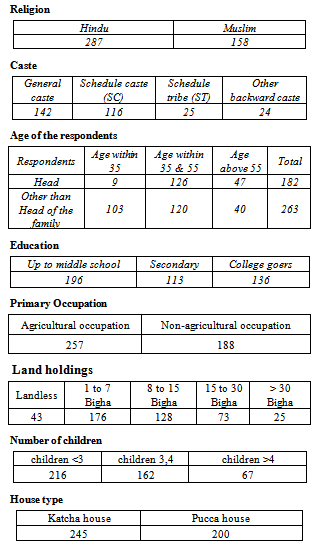 |
| |
|
4. Analysis and Discussion
4.1. Major Highlights
402 respondents out of 445 were land owners, remaining were either landless labour or engaged in non-agriculture occupation. Based on the combined responses of the sample survey of the five districts of central Bengal, the broad findings have been as followsa) Out of 402 land owning respondents, 247 (61%) have shown willingness to part with their land for industry or for building hospitals or schoolsb) There are 43respondents in the survey who do not own land. Out of them, 24 are engaged as agriculture labour. Only 2 (8%) out of 24 have agreed with the proposal of giving land for non-agriculture uses, indicating landless agricultural workers’ opposition to such transfer. However, among the remaining 19 landless respondents, who are engaged in non-agriculture occupations, 6 out of 19 (32%) have agreed with the proposal to part with their village land for industry. c) Of the 402 land owning households, 245 (out of 247 willing respondents) are indifferent as to whether the acquired land would be used for industry, schools or hospitals. This indicates their lack of concern for the “ends approach”. d) Compensation expectations of the willing respondents also do not vary depending on the future end use of the land.e) All “willing” respondents have asked for employment of at least one member of the family in addition to the financial compensation.Following from the above highlights this paper has further gone on to build the detailed profile of the respondents who show willingness to part with their lands.
4.2. Model Equation
The model which is used in this paper incorporates the following socio-economic parameters as independent variables viz. age , education , occupation , religion, caste, number of children in the family, landholding size, house type and ownership period. These variables were selected based on the pilot survey carried out among a few land owners as well as feedback from NGOs who have grass root level knowledge of village societies.For the purpose of this study, the independent variables, where ever relevant, have been partitioned into broad class intervals (See Data Description).The specified equation is:Willingness/ Unwillingness to part with the land =a1 + a2* age + a3* education + a4* occupation +a5* religion + a6* caste + a7* number of children in the family +a8* landholdings +a9* house type + a10*ownership period.Table 3. Codes used for the attributes in the model-
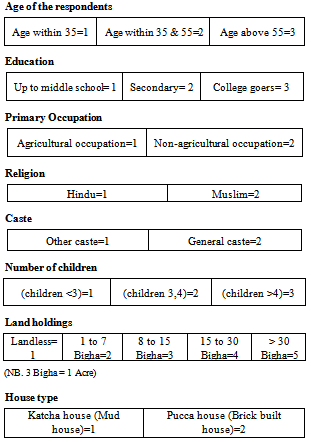 |
| |
|
4.3. Analysis & Discussion
The binary logistic regression analysis shows a very good association between the dependent variable ‘willingness to part with’ and the set of independent variables. Table 4. Logistic Regression Coefficients
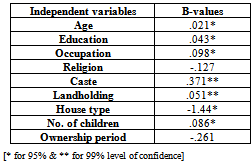 |
| |
|
The equation as a whole is a ‘good fit’ as shown in the Table below.Table 5. Omnibus Tests of Model Coefficients
 |
| |
|
It is clear that some of the factors have greater significance than others (Table 4). For the purpose of the current study, factor analysis is carried out to identify a smaller set of factors that can explain most of the variance considered for the profiling purpose (Table 6). Table 6. Correlation matrix
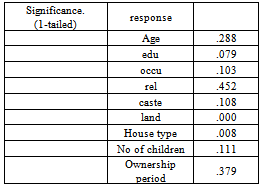 |
| |
|
Table-6 shows that the following variables have significance values closest to ‘000’ level indicating “best fit”:ØLand HoldingØHouse TypeØEducation ØOccupation ØCasteIn order to go beyond the simple profiling of “willing” or “unwilling”, further analysis has been done to develop more sharply nuanced profiles of those who are “willing” to part with their land.
4.3.1. Combinatorial Analysis
Each of the five key variables, shown above has been combined with the rest of the four variables in paired combinations to bring out the multi-variable influences on the willingness profile. Willing respondents among the landless being small in number (especially those who are agricultural labor), they are not taken separately for any further combinatorial analysis and are combined with the small and marginal farmers (up to 7 Bigha) to study the multi-variable influence. Land as BaseWith the increase in size of the Land holding the willingness to part with the land increases (B-value high and +ve). 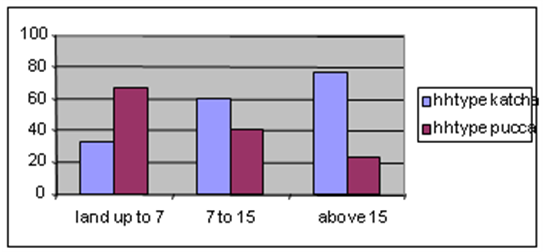 | Figure 3. Land-House type |
Comments: In this figure when the House-type is combined with the land holding size, it is noticed that as land holding increases, the percentage of willing respondents living in Katcha houses (mud-house) also increases.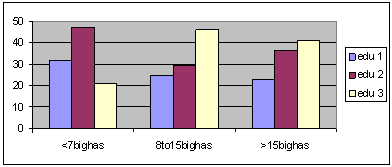 | Figure 4. Land-Education |
Comments: Among the willing respondents of different land holding segments, it is observed that proportion of people with higher levels of education increases with the land holding size. Though there is a small dip when large land holding is combined with highest level of education, it really does not affect the “trend” observation.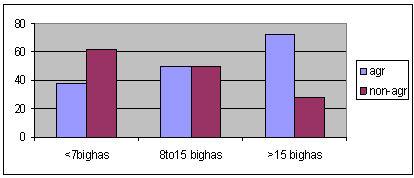 | Figure 5. Land-Occupation |
Comments: When land holdings of different sizes are combined with the occupation of the respondents, percentage of willing respondents working in agriculture increases with the increasing land holding size. This is almost opposite of the picture when the land holdings are combined with non-agricultural occupations. 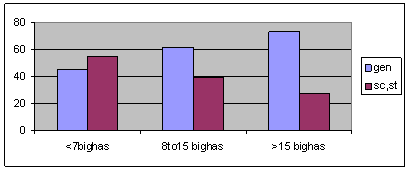 | Figure 6. Land-Caste |
Comments: Among the willing respondents percentage of respondents belonging to general castes increases with the land holding size. This is in contrast to what is being observed in case of SC and ST communities. Education as base:With the increase in Education the willingness to part with the land increases (B-value high and +ve)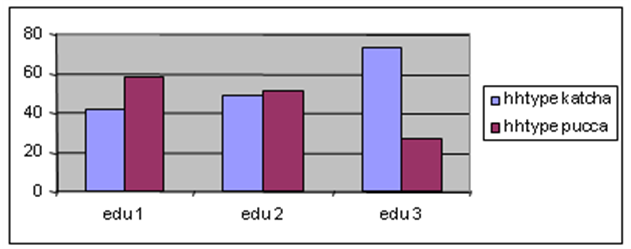 | Figure 7. Education-House type |
Comments: As education level increases, a greater percentage of willing respondents tend to have Katcha houses (mud houses).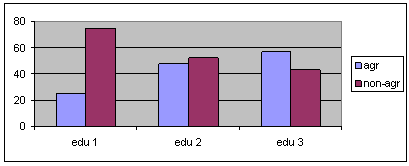 | Figure 8. Education-Occupation |
Comments: Proportion of respondents engaged in agricultural occupation rises amongst the willing respondents as the education level increases. A reverse trend is observed for people with non-agricultural occupation. 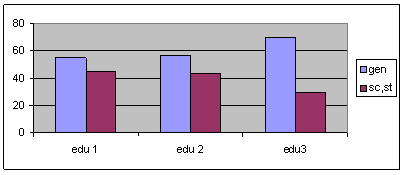 | Figure 9. Education-Caste |
Comments: Proportion of general caste respondents is relatively higher among the willing respondents at higher level of education (level 3). In case of SC and ST groups a reverse trend is noticeable.Occupation as base: With the movement in occupation (from agriculture to non-agriculture) the willingness to part with the land increases (B-value high and +ve)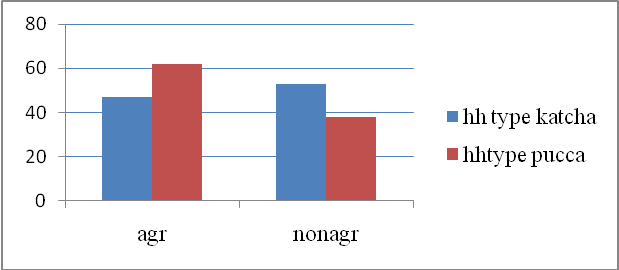 | Figure 10. Occupation-House type |
Comments: Among the willing respondents, proportion of respondents living in Katcha houses (mud-house) is more in non-agriculture occupations than in agriculture occupations.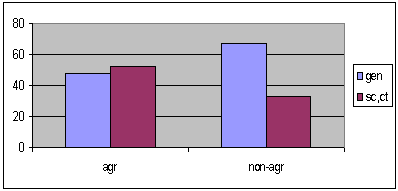 | Figure 11. Occupation-Caste |
Comments: Proportion of general caste respondents is relatively higher among the willing respondents from non-agriculture occupation. But SC and ST groups show an opposing trend.Caste as base:Caste shows a strong correlation with the willingness to part with the land (B-value high and +ve)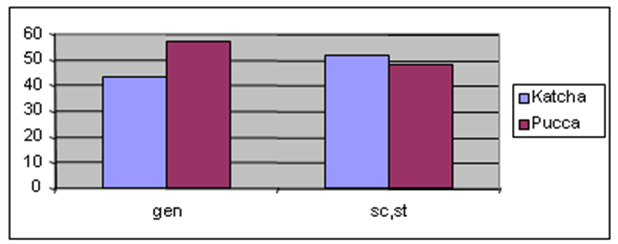 | Figure 12. Caste-House type |
Comments: Among the “willing” respondents proportion of people staying in “pucca” (brick built) houses is more amongst the general caste groups.
4.3.2. Overall Comments on the Combinatorial Analysis
Education and non-agricultural occupation are two independent variables which have strong stand alone correlations with the respondent’s willingness to part with the land (B values high and positive and “best fit”) but when viewed in combination with the higher (more than 15 bighas) land holdings, the proportion among willing respondents either reduces significantly (Occupation-Land Holding) or at least marginally (Education-Landholding). This apparent contradiction may be explained if viewed from the perspective of the present state of the agricultural economy of rural India. Agriculture today is an unattractive proposition because of high input costs and volatile price movements of the agriculture produces. But wealthier section of the rural population (larger land holdings) who are educated with more contemporary knowledge base and engaged in non-agricultural occupations are better equipped to take advantage of the volatility compared to less affluent counter parts. This might have caused the difference in their response. The educated but less wealthy land owners are instead looking forward to shift to non-agricultural occupations for better living. Barring the General Caste members, respondents residing in katcha houses (mud house) are generally more willing to part with the land than those staying in pucca houses (brick built). Katcha house is an indication of weak financial position of the respondents. This may offer an explanation as to why they are more willing to give up their lands.It is of interest to note that SC and ST respondents are less willing to part with their land even among the respondents with higher education or land holding. This may be due to their actual experience of lack of opportunities beyond agriculture vis-a-vis general caste respondents. The observations in this section are conjectures and hypotheses to explain the combinatorial findings. Their broad purpose is to encourage future research to test some of these hypotheses.
4.3.3. The Final“Profile” Characteristics of the “Willing” Respondents
The Venn diagram below pictorially brings out the most “likely” profile of a “willing” land giver.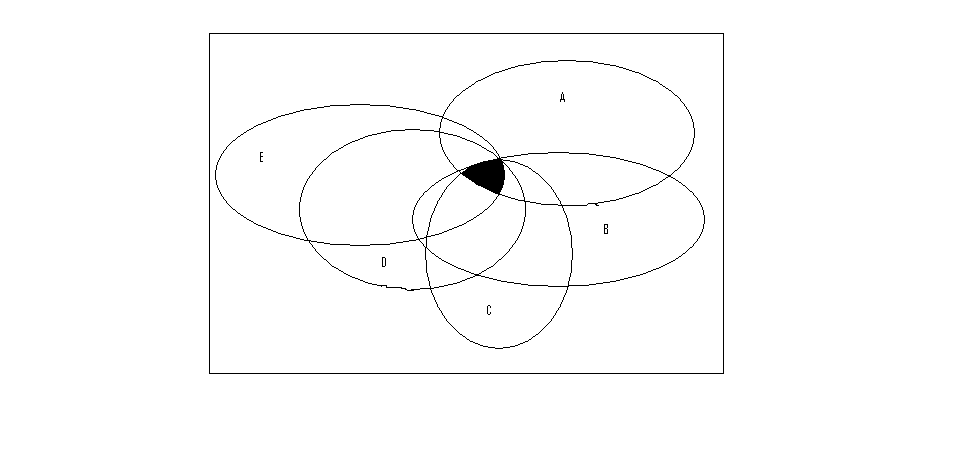 | Figure 13. The “profile” of the “willing” respondents |
According to the above diagram, five most important socio-economic factors are represented by the five ovals. The dark portion is the combination of all five, and these people, having ‘good education’, ‘good amount of landholdings’, working in ‘non-agricultural occupation’, having ‘kaccha houses’ and belonging to ‘general caste’, are more willing to part with their land for non-agricultural purposes.
4.3.4. Predicting Willingness to Part with Land
Based on the above analysis, it may be concluded that there is statistically significant influence of education, occupation, land holding, house type and caste in shaping the decision to give land for other uses. The functional form of the relationship of response with all the five factors works out to beWilling = f(household landholdings, katcha housetype, higher education, general caste, non-agricultural occupation).The functional relationship as stated above can now be shown below in the form of an equation with the relative weights.Response = 3.132 education + 0.81 occupation + 17.66 land + 2.098 caste - 5. 61 house type + Constant
4.3.5. Compensation Expectations
“Willingness” to part with land is inseparable from appropriate compensation to the land owners. It is difficult to estimate what constitutes “fair market value” of land, based on the land owner`s expectation, especially in the event of involuntary separation. During the survey, the respondents indicated their expectations as multiples of the current market value as fair compensation (Fair Market Value). As expected, this amount reflects a significant amount of solatium component to compensate for adversarial acquisition. It might be of interest to note that the amount of solatium shows a steadily rising trend as the respondents’ proximity to the State political capital, Kolkata, increases.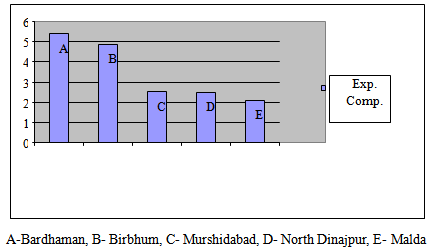 | Figure 14. Expected compensation for the districts surveyed |
Proximity to the political capital often leads to higher bargaining power. Rising trend in the expected compensation by the land losers closer to the State’s political capital may be an indication of this awareness. Compensation proposed by the Government of India in the new Land Bill (pending in the Parliament for approval) may have also considered the political costs rather than the financial ones.
5. Conclusions
The most important findings of this study are two-fold. A majority of the respondents (61%) have shown willingness to part with their land for industrialization or for other public purposes based on an “expected” level of compensation (which is varying) and employment for at least one family member. But overwhelming majority of the landless laborers engaged in agriculture is opposed to such transfer of land for non-agricultural use. This can be explained by a fear of loss of employment, a fear of “lack of entitlement’ to a “fair share” of compensation and a very uncertain future created by absence of transferable skills. In a dynamic environment of rapid legislative policy changes and their legal interpretations, it becomes extremely important to define the “willingness” profile of the land giver in a developing country like India, where nearly 70% of the population is dependent on agriculture for their livelihood. Since people are at the center of this political process in a democracy, understanding people`s opinion, desires, aspirations and dreams are crucial for creating a proper discourse on this issue of “land acquisition”. Our study is a small step towards creating such understanding in this focused area. A corollary lesson learnt from this study is that it is extremely important to not subject the rural population to a “one size fit all” fallacy. Rural India is changing and changing fast. Thus, it is important to develop segment based insights about them. This is precisely why it is critical to develop a system of “dynamic profiling” of the rural population to capture the changing scenario of the rural landscape.
References
| [1] | Harvey M. Jacobs (2008): The Future of the Regulatory Takings Issue in the United States and Europe: Divergence or Convergence?; The Urban Lawyer Vol. 40, No. 1 Winter 2008, P 59 |
| [2] | Ellen Frankel Paul, Property Rights and Eminent Domain; New Brunswick, NJ: Transaction Books, 1987, P 74-75 |
| [3] | Vince Mangioni, 2009: The evolution of the ‘Public Purpose Rule’ in compulsory acquisition p. 2 |
| [4] | Thomas J. Miceli and Kathleen Segerson: 6200 Takings: http://encyclo.findlaw.com/6200book.pdf , 29th May 2012 |
| [5] | Steven Shavell (2007): Eminent Domain Versus Government Purchase Of Land Given Imperfect Information About Owners’ Valuations; Discussion Paper No. 598; 10/2007 |
| [6] | Thomas Kalbro (2007): Private Compulsory Acquisition and the Public Interest Requirement;; International Federation of Surveyors; Sweden, Sep. 2007 |
| [7] | Thomas W. Merrill (1986); The Economics of Public Use; Cornell Law Review, November, 1986. |
| [8] | Richard A Epstein: Takings: Private Property and the Power of Eminent Domain by RICHARD A. EPSTEIN, 1985 ISBN 0-674-86728-9, Ch.12, P166. |
| [9] | Robert C. Bird, 2010: Reviving Necessity in Eminent Domain; P 256-264;http://www.harvard-jlpp.com/wp-content/uploads/2010/01/bird.pdf , 12th June, 2012 |
| [10] | Lynch et. al v. (1972) Household Finance Corp., U.S. Supreme Court, 405 U.S. 538 |
| [11] | Berman Vs Parker (1954): U.S. Supreme Court (348 U.S. 26) |
| [12] | Wayne County v. Hathcock (2004): 684 NW 2d 765 Michigan: Supreme Court |
| [13] | Kelo vs. City of New London (2005): U.S. Supreme Court (545 U.S. 469) |
| [14] | DevSharan and Others vs State of UP and Others, 7 March 2011, Supreme Court of India. |
| [15] | JayantaBandyopadhyay, Tapas Roy (2012): Political Challenge of an Intensifying Conflict over Land; Vol. xlvii no 7 EPW Economic & Political Weekly, February 18, 2012. |
| [16] | Richard A Epstein: Takings: Private Property and the Power of Eminent Domain by RICHARD A. EPSTEIN, 1985 ISBN 0-674-86728-9, Ch.12, P164 |
| [17] | Joseph Mascioli et al: In re Town of Islip; 49 N.Y.2d 354; NY: Court of Appeals 1980http://newyorkeminentdomain.com/site/publications/48-highest-and-best-use?format=pdf, 7th July, 2012 |
| [18] | John Bratland (2006), On The Impossibility of ‘Just Compensation’ When Property Is Taken: An Ethical and Epistemic Inquiry; U.S. Department of the Interior, 2006 |
| [19] | Richard A Epstein : Takings: Private Property and the Power of Eminent Domain by RICHARD A. EPSTEIN, 1985 ISBN 0-674-86728-9, Ch.18 |
| [20] | Guido Calabresi. and Douglas Melamed. (1972): Property rules, Liability rules and Inalienability: One view of the Cathedral; 85 Harv L Rev 1089, 1110. |
| [21] | Richard A Epstein: Takings: Private Property and the Power of Eminent Domain by RICHARD A. EPSTEIN, 1985 ISBN 0-674-86728-9, Ch.13, P182 |
| [22] | Yun Chien Chang (2012): Economic Value or Fair Market Value : What form of Takings Compensation is efficient?, Supreme Court Economic Review, Vol. 20. |
| [23] | Coniston Corporation, et al., Plaintiffs-Appellants, v.Village of Hoffman Estates, et al., Defendants-Apellees ; United States Court of Appeals for the Seventh Circuit; No. 87-1890; February 8, 1988, Argued—April 20, 1988, Decided; Lead Opinion by Judge Posner. |
| [24] | Adam Rubin,2012 : The Changing Face of Eminent Domain Law in Michigan: Amending Article X, Section 2 of The Michigan Constitution. |
| [25] | Frances Plimmer (2008): Compulsory Purchase and Compensation: an overview of the system in England and Wales |
| [26] | AnjaniMoluDessai Vs. State of Goa,http://www.stpl-india.in/scjfiles/2010_stpl(web)_1083_sc.pdf , 10th July, 2012 |
| [27] | Rachelle Alterman, (2007): When The Right to Compensation for “Regulatory Takings” goes to the Extreme: The Case of Israel, Washington University Global Studies Law Review,Vol. 6:121, P 149. |
| [28] | Daryl J. Levinson (2000): Making Government Pay: Markets, Politics, and the Allocation of Constitutional Costs; The University of Chicago Law Review, Vol. 67, No. 2; Spring 2000. |
| [29] | Glynn S. Lunney, Jr., Michigan (2000): Takings, Efficiency, and Distributive Justice: A Response to Professor Dagan; Law Review, Oct. 2000. |
| [30] | Nandigram Violence, The events of 14th March 2007, Wikipedia, 24th July, 2012. |
| [31] | TATA pulls out of Singur, blames Trinamool stir; Financial Express, 4th October, 2008. |
| [32] | NSS Report 494: Seasonal Variation in the Operational Land Holdings in India, 2002-03, Chapter 3: Summary of Findings, Statement 3. Planning Commission.nic.in. |















 Abstract
Abstract Reference
Reference Full-Text PDF
Full-Text PDF Full-text HTML
Full-text HTML




